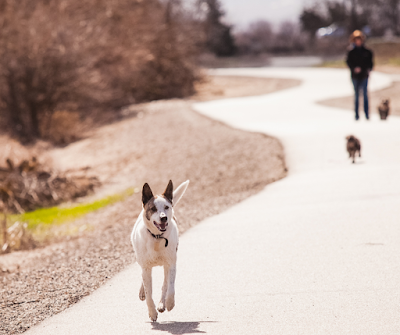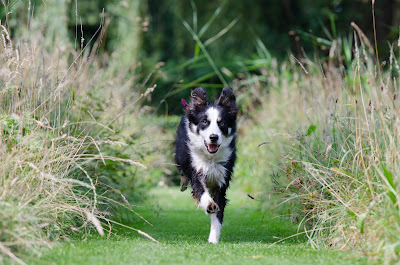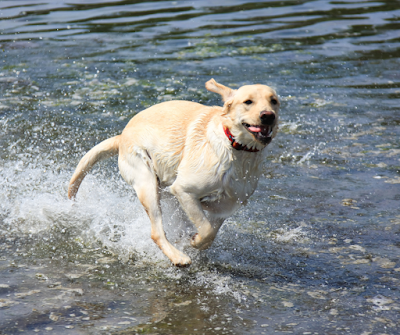One of the most common problems dog guardians report is that their dog won’t come back when called. Failure to recall can be frustrating, embarrassing and – in some cases – dangerous. A dog who will not return when called could run up to other dogs, who may or may not want to interact. They may run up to unknown people – surprising as it may be, not all people love dogs. Shocking, I know, but people do exist who don’t like dogs! The dog may reach the end of the safe area and run out into a road, with the potential for catastrophic consequences.
For those people who share their lives with fearful or anxious dogs, seeing an off lead dog running towards them is a worrying sight. Especially so if they can hear the fruitless calls from the unknown dog’s human and can see the dog is not listening. It doesn’t matter how friendly those strangers may think their dog is, or whether ‘he just wants to play!’ it’s important that we ensure we don’t allow dogs in our care to approach others uninvited.
 |
| If this was your dog, would they come back if called? |
I have written before on how to get recall right from the very beginning with a new puppy, but the concept of training a recall is the same with an adult dog. "Being able to recall your dog and see them zoom straight back to you full of enthusiasm to be with you is a great feeling, and a vital part of being a responsible dog guardian."
 |
| Seeing your dog rocketing back to your call is a wonderful sight! |
How do we teach a great recall, and ensure that the ‘come back’ button works wherever we go?
Teach It Right
Like everything else with dogs, recall is something that we need to teach them. No dog is born knowing that they have to return to their human on hearing their name or the word ‘come!’
For any cue we teach our dogs we must generalise or ‘proof’ it. This means starting out learning in the house and then the garden at home and, once the dog gets the idea there, gradually introducing the cue in different areas with more distractions. Just because a dog knows what ‘come’ means at home, they don’t understand that it means the same thing in the big field with lots of interesting smells and what they may see as potential playmates.
A long line attached to a harness is a great way to let your dog have more freedom while still having hold of them if needed, and is a brilliant middle ground between on lead and off lead when moving the teaching into bigger and potentially more distracting locations.
Below is a video of my own dog on his long line. He is an anxious boy with a tendency to display reactive behaviours, so we have him on a long line if there's a chance we may encounter other people and dogs unexpectedly.
Reward Generously
We need to ensure that our dogs think coming back to us is a great idea. For that reason, it’s essential that we reward them when they do. Coming back when called gets them something they like and want. Recall is something I never stop rewarding throughout the lifetime of my dogs. When my boy Finn returns on hearing the cue, he’ll get a treat or some fuss. He doesn’t know which of those he will get, but that one is definitely coming.
 |
| Would you walk away from something you enjoyed for nothing? |
We also have a cue for an emergency recall, one for when the situation may become difficult and I need him to come back NOW. I use a dog whistle for this, to ensure the cue stays as consistent as possible. Returning to that whistle gets him a jackpot – several pieces of the highest value rewards I’m carrying at that time. I want him to know that coming back to that whistle is always worth his while, and so I pay him accordingly.
A word of warning: while a dog who doesn’t come back when called can be embarrassing and frustrating, it’s important we reward them when they do come and don't let any anger or frustration show. Punishing the dog isn’t going to make them come back faster next time. It’s more likely to have the opposite effect and make them even less keen to return, as they will associate coming back to negative consequences.
Catch and Release
One mistake people often make is to let their dog off the lead to run for a while, then at the end of the walk or play session recall their dog, clip the lead on and go straight to the car or start to walk home. This can poison the recall cue as the dog learns coming back means an end to fun.
To avoid this happening is quite simple. While the dog is off lead, call them back a few times at random intervals to reward them and immediately send them away again to run and explore and do dog things for a while. This way coming back doesn’t always signal the end of the fun, and means your dog is more likely to come back when you call them.
 |
| Call, reward, and release several times during an off lead walk |
If you want to find out more about how to get a brilliant recall with your dog, check out the Canine Principles workshop ‘Rock Solid Recall’ for great advice and tips.
* * * * *
Understanding Reactive Dogs is now available as an audiobook as well as in ebook form and as a paperback via Amazon, or also direct from me in the UK.
No comments:
Post a Comment